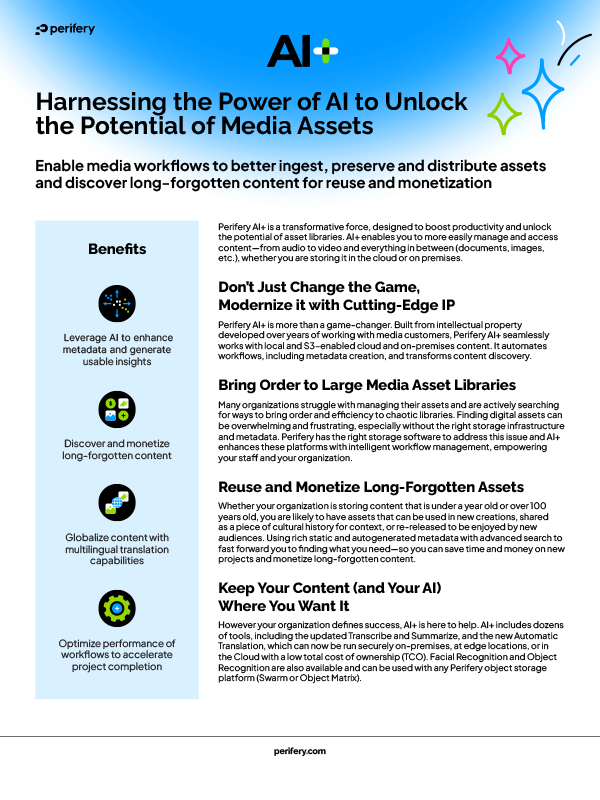
Recently, I had the pleasure of hosting my colleagues Jordan Woods and George Maddocks, two of Perifery’s expert solution architects, on a webinar about getting more value from your Tier 1 storage without the expense of expanding it with more Tier 1 storage. (Watch the webinar.)
Jordan Woods, who suggested the topic for this webinar, is based in Los Angeles in the Western part of the United States and has worked in the M&E storage industry for almost 20 years. He has worked on a wide variety of storage products—from tier 1 all the way to archive—both designing and implementing solutions.
Based in London, George Maddocks came to Perifery through the Object Matrix acquisition and, while he claims to be less storied in storage than Jordan, has about the same amount of time in the M&E industry. His background in Video on Demand (VoD) and nonlinear editing has been around distribution, sharing and ingest. The tremendous need to coordinate the movement of assets across different storage tiers and to do different things with those assets is at the root of his advocating for better granular tiering of media assets.
Fast, Shiny and Pretty! Why Not Always Use Tier 1 Storage?
I commented to Jordan and George that everybody loves their fast, shiny, pretty tier 1 storage and posed the question, “Does that tempt some organizations to just use it for everything?” George responded with an analogy about running a moving company, that went something like this.
You advertise that you're going to move any amount of stuff, but the only thing you buy for moving is a 7.5 tonne lorry. You purchase them so you never turn up for a job with a lorry that's too small, but you waste resources (petrol/gas). This is similar to the huge amounts of organizational efficiency that are often lost by not selecting the right tool for a job. So, if you don't consider organizational efficiencies and cost, you will forever just pay more than you need to and do things less efficiently.
George went on to remind us that the M&E industry is in flux—distributors are not getting $15 a DVD anymore, and they are not getting another $15 by re-releasing it on Blu-ray. They get to sell it once on Netflix and only get a finite amount of that money. Therefore, organizations have to do more with less and achieve more granular efficiencies moving forward.
What Storage Choices Need to Be Made?
The discussion turned back to why you might want to have a variety of storage options in your infrastructure, with the obvious reason being so that you are not wasting a bunch of money! There are many people who buy multiple petabytes of flash storage, which is a waste of their organization’s resources. When they really query what's in their storage, the “hot” part (the assets they're actually engaging with) of their storage is maybe a couple of hundred terabytes, however, they buy more tier one to avoid making decisions about what to move off of tier 1 and into an archive. Every editor knows that they might need a random piece of content in the future, but meanwhile they haven't touched it in six months or a year. Then, of course, there is often moving of assets to LTO. However, if you do need to bring assets back from LTO, it is slow and you might not know exactly what is on that tape. If you can’t find what you need quickly, is it even worth having?
This lively part of the conversation between George and Jordan clearly highlighted the importance of thinking through storage strategy for many reasons, with cost savings and efficiency clearly at the top of the list.
Where Does Perifery Fit In?
Perifery offers high-performance archival storage. George explained, “You know, let's not mess around, we're an archive, right? You know, we're not here to be edited off. We can do some editing off it, but it's not there to be your everyday edit driver...as we know with the Object Matrix and the Swarm storage, we can do ingest, we can do distribution.”
Jordan expounded on our progress with AI and how we are quickly moving towards understanding more about our data as metadata continues to improve and is enriched by things such as facial and object recognition. That understanding of what is in an archive for reuse provides the opportunity to get a bit more money out of those assets.
Do We Have to Talk About Monetization Again?
“I know it's kind of like a tired topic, right? Monetize your archive. We've heard that for probably a good solid decade now. But, in the last couple of years, it's becoming a bit more of a reality. And that's where you want your media assets sitting on a Perifery Object Storage platform—so you can have the most cost-efficient, multiple petabyte access with high-performance access. We're not talking about slow coming off a tape, you know, it's gigabytes per second of performance coming back to your tier 1. So, you know, as an editor, if that file is coming back to your main tier 1, it's going to happen faster than you even realize,” opined Jordan.
What About LTO?
George mentioned that he did a Tech Talk podcast on LTO and believes that you cannot underestimate the sheer amount of content stored on tape. Elaborating on what he sees as the difficulties around using tape, he recounted the story of a previous employer that went heavy on LTO and the “sigh moment” when he would realize that what he needed to work on was on tape. That 10 to15 minutes of wait time involved was not quite enough time to finish another task, and was likely to tempt one to push that assignment until late in the workday or not get around to it at all.
We aren’t anti-LTO, and Perifery storage can (and often does) work in an environment that also uses LTO. However, our storage architects generally recommend that you use Perifery storage for archiving for just a few simple reasons: It is less time-consuming, simpler to locate the specific media asset you need, and it enables you to discover hidden gems in your collection while keeping your content better protected.
Business Continuity and Disaster Recovery
As we broached the topic of Business Continuity and Disaster Recovery (BCDR), George commented, “As you find these niche channels, and this concept becomes more and more valuable, the notion of some content is valuable and some content is not, and some content you could bear to lose is no more, right? You do not know what suddenly is gonna become a brand new exciting FAST channel next week, so everything needs to be safe and everything needs to be secure. We are absolutely all about the ability to write off to a second copy somewhere geographically separate, keep a dual copy across nodes. I think it's fair to say, Jordan, as well, that the Object Matrix stack does dual copy across servers, so a node can go pop, and it also does automated replication. I think the Swarm makes good play of geospecific and erasure coding, doesn't it?”
Jordan agreed, endorsing the practice of replication across clusters. He went on to talk about what he has seen over his career, “I would say it's a funny thing I've run over the years in media and entertainment when you talk about disaster recovery and business continuity, that people will have the backups or they'll have something that gives them some sense of disaster recovery. But if you ask them how long it would take for those files to come back, are they working again? Are they still in business? So, and that could be like, is it because they chose cloud as their archive, right? Cause pulling back from the cloud could take, depending on where you went, right? If you went to Glacier, it's like, okay, well, I'll see you in a couple of weeks, right? So yeah, they're important topics.”
George surmised that “although insurance will cover your burnt drives, I wonder whether insurance has got smooth enough and swift enough to cover the cost of pulling everything back from Glacier all at once” and then mentioned that could be "a pretty serious egress cost.”
We continued to talk about the potential cost of losing access to data and assets, emphasizing that object-based storage is often used in verticals outside M&E, such as law enforcement, medical and financial institutions, where any loss of asset availability can be catastrophic—a testimony to the reliability and resilience of the nearline and active archive storage products that Perifery produces.
The Perifery Technology Portfolio
George and Jordan gave a quick overview of the Perifery technology. If you are not yet familiar with our technology, I highly encourage you to visit the Perifery website where you can find overviews of our solutions, details about our products, and resources for deeper understanding.
Talk to Our Experts!
My belief in the value of our products is only exceeded by my confidence in our team. We take a consultative sales approach and have highly qualified, experienced solutions architects that are passionate about making sure you have the best fit of technology for storage and workflows for your organization. After implementation of Perifery solutions, we have an amazing award-winning team of engineers that provide support.
Contact us through our website or email us at info@perifery.com. You can also visit George at IBC this month, or catch up with me and Jordan in NYC at the NAB Show this October.
